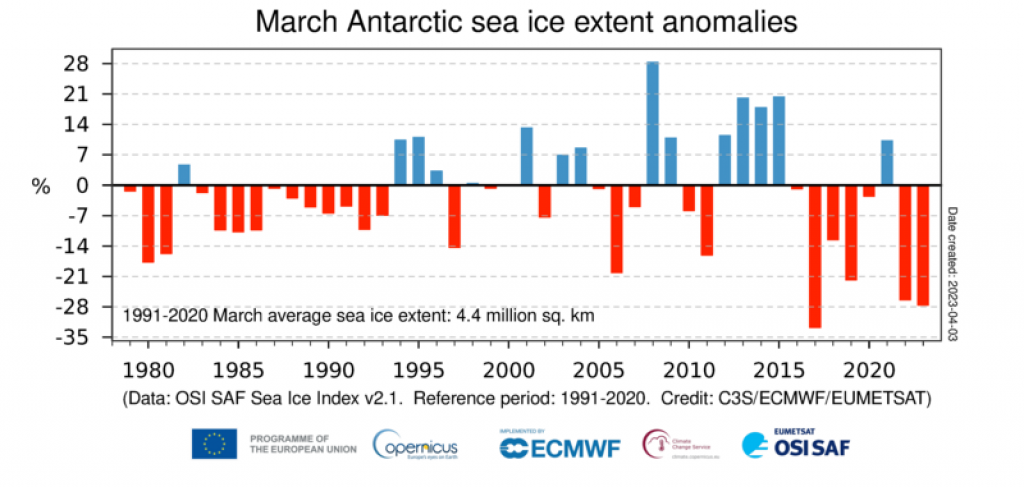

European meteorological agency noted world’s second joint warmest March on record; Antarctic sea ice the second lowest on record



March 2023 saw variations on several meteorological fronts, according to the Copernicus Climate Change Service (C3S). A monthly climate bulletin found that the world had the second joint warmest March on record and Antarctic sea ice was the second lowest on record, said the World Meteorological Organization.
The C3S is implemented by the European Centre for Medium-Range Weather Forecasts on behalf of the European Commission. The monthly climate bulletins report the changes observed in global surface air temperature, sea ice cover and hydrological variables.
Temperatures were above average over southern and central Europe and below average over most of northern Europe, the C3S found. New high temperatures records were set in March for a vast swathe of land over North Africa, south-western Russia and most of Asia, as it was much warmer than average.
Read more: The snows of Kilimanjaro could vanish by 2040 due to climate change: Report
North-eastern North America, Argentina and neighbouring countries, a large part of Australia and coastal Antarctica also saw temperatures much above average.
Contrastingly, it was much colder than average over western and central North America.
Antarctic sea ice extent hit a record low in February. With the second lowest satellite data record, March didn't see much improvement, at 28 per cent below average. Sea ice concentrations were also much below average in all sectors of the Southern Ocean.
Arctic sea ice extent was 4 per cent below average, ranking joint fourth lowest for March in the satellite data record, but also close to the three lowest extents. However, Greenland Sea noted a contrast, with concentrations well above average.

Time series of monthly mean Antarctic sea ice extent anomalies for all March months from 1979 to 2023. The anomalies are expressed as a percentage of the March average for the period 1991-2020. Data source: EUMETSAT OSI SAF Sea Ice Index v2.1. Credit: Copernicus Climate Change Service/ECMWF/EUMETSAT
The west-to-northeast band across northern Europe and Türkiye saw wetter than average conditions. Whereas most of the Iberian Peninsula, the Alpine arc, parts of Central Europe, the eastern Balkans and the north-western coast of the Caspian Sea experienced drier-than-average conditions in March.
Read more: World may temporarily breach 1.5°C in the next five years: WMO
Beyond Europe, in March 2023, it was wetter than average over parts of the USA, several regions of Asia, the Horn of Africa, New Zealand, northern Australia, part of southern Africa, and Brazil. In many regions heavy precipitation led to flooding.
It was drier than average over Argentina, which experienced continuing drought, southern Australia, south-western Africa and parts of Asia. In many cases, these conditions were associated with warmer-than-average temperatures.
All the reported findings are based on computer-generated analyses using billions of measurements from satellites, ships, aircraft and weather stations worldwide.
WMO uses Copernicus data as one of the six leading global datasets to compile its own State of the Global Climate reports. WMO will publish the State of the Global Climate 2022 report on 21 April.
We are a voice to you; you have been a support to us. Together we build journalism that is independent, credible and fearless. You can further help us by making a donation. This will mean a lot for our ability to bring you news, perspectives and analysis from the ground so that we can make change together.

Comments are moderated and will be published only after the site moderator’s approval. Please use a genuine email ID and provide your name. Selected comments may also be used in the ‘Letters’ section of the Down To Earth print edition.